Machine appliqué embroidery is a versatile and creative technique that allows you to embellish fabric with stunning designs, adding depth and visual interest to your projects.
Whether you’re a seasoned embroiderer looking to expand your repertoire or a beginner eager to explore the world of machine appliqué, this article will provide you with expert applique tricks and tips to achieve breathtaking results.
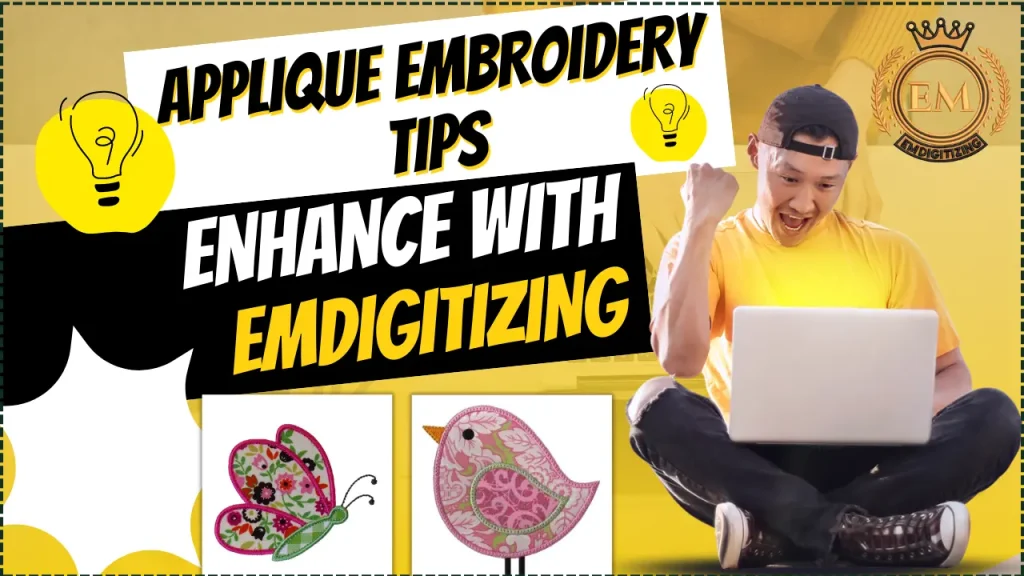
From selecting the right materials and preparing your fabric to mastering various appliqué techniques and troubleshooting common issues, you’ll gain valuable applique embroidery tips and knowledge to take your machine embroidery to the next level.
Get ready to unleash your creativity and transform your projects into works of art!
Applique Embroidery Tips: Enhance With EMdigitizing
What is Machine Appliqué Embroidery
Machine appliqué embroidery is a technique that allows you to add decorative fabric designs to your projects using a sewing machine. It involves layering fabric pieces and stitching them onto a base fabric to create beautiful and intricate designs.
Whether you’re embellishing a quilt, a garment, or a home decor item, these embroidery machine applique tips adds a unique and personalized touch to your creations.
Advantages of Machine Appliqué Embroidery
There are several advantages to using machine appliqué embroidery. First and foremost, it saves time compared to hand appliqué techniques. With a sewing machine, you can quickly stitch down your fabric pieces and move on to the next step of your project.
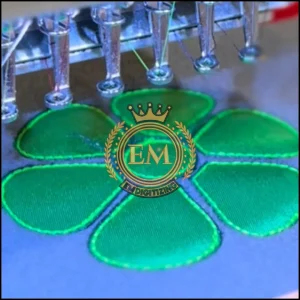
Machine appliqué is also more durable since the stitching secures the fabric firmly in place. This means your appliqué designs will withstand regular wear and washing, making them perfect for items like t-shirts or children’s clothing.
Plus, with the wide variety of decorative stitches available on sewing machines, you can easily customize your appliqué designs and unleash your creativity.
Choosing the Right Materials and Supplies for Machine Appliqué Embroidery
First tip from applique embroidery tips is selecting the appropriate materials and supplies. It is crucial for achieving success in machine appliqué embroidery.
Selecting the Appropriate Fabrics for Machine Appliqué
When choosing fabrics for machine appliqué, consider their weight, drape, and colorfastness. Opt for lightweight fabrics like cotton or linen, as they are easier to stitch and less likely to cause puckering.
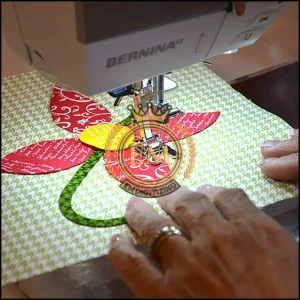
It’s also important to ensure that the fabric is colorfast, especially if you plan on washing the finished project. You don’t want your appliqué design to bleed or fade over time.
Choosing the Right Stabilizer
Stabilizers play a crucial role in machine appliqué embroidery. They provide support to the fabric during stitching and prevent puckering or stretching.
Here is applique embroidery tips, consider using tear-away or cut-away stabilizers, depending on the complexity of your design.
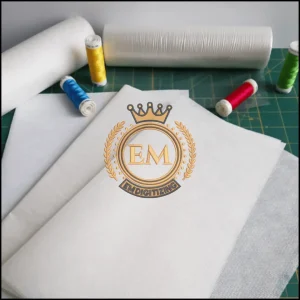
Tear-away stabilizers are easy to remove once the stitching is complete, while cut-away stabilizers provide long-term support, making them ideal for heavier fabrics or intricate designs.
Picking the Suitable Thread for Machine Appliqué Embroidery
When it comes to thread selection, consider both color and quality. Choose a thread color that complements your fabric and enhances the overall design.

Quality-wise, opt for polyester or rayon threads specifically designed for machine embroidery. These threads are strong, and durable, and offer a beautiful sheen that adds a professional touch to your appliqué designs.
Preparing Your Fabric and Design for Machine Appliqué Embroidery
Tips for applique embroidery is preparing your fabric and design. It is a foundational step in machine appliqué embroidery, setting the stage for a smooth and successful embroidery project.
Preparing the Fabric for Appliqué
Before starting your machine appliqué embroidery, it’s essential to prepare your fabric properly. Prewash and press your fabric to eliminate any shrinkage or wrinkles.
This step ensures that your appliqué design remains intact even after subsequent washes.
Additionally, if you’re working with stretchy fabrics, consider using a stabilizer or interfacing to prevent distortion during stitching.
Designing and Transferring the Appliqué Pattern
Next, design or choose the pattern for your appliqué. You can sketch your own design or use pre-made templates or embroidery software.
Once you have your design, transfer it onto the fabric using your preferred method, such as tracing with a fabric pen or using heat transfer paper.
Make sure the design is centered and aligned correctly before moving on to the stitching process.
Techniques for Machine Appliqué Embroidery
Mastering various applique embroidery tips in machine embroidery can elevate your projects from simple to spectacular, offering a range of creative possibilities.
Raw Edge Appliqué Technique
The raw edge appliqué technique involves stitching the fabric pieces directly onto the base fabric without turning the edges under.
This technique gives a casual and textured look to your appliqué designs. To prevent fraying, you can use a small zigzag or satin stitch to secure the fabric edges.
Fusible Web Appliqué Technique
The fusible web appliqué technique involves using fusible web or heat-activated adhesive to attach the fabric pieces to the base fabric.
This technique offers precise and clean edges, as the adhesive helps hold the fabric in place during stitching.
Simply iron the fusible web onto the fabric pieces, position them on the base fabric, and stitch around the edges.
Reverse Appliqué Technique
Reverse appliqué is a technique where you layer fabrics together and stitch around the design, then cut away the top layer to reveal the fabric underneath.
It creates a stunning dimensional effect and allows you to showcase different fabric colors and textures.
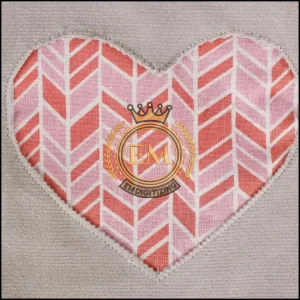
Before stitching, mark and cut the top layer of fabric within the design, shape, leaving a seam allowance.
Then, stitch along the marked lines, trim the excess fabric, and carefully cut away the top layer to expose the fabric beneath.
Finishing Touches and Adding Details to Machine Appliqué Embroidery
Adding finishing touches and details to machine appliqué embroidery is what truly brings your work to life, transforming a basic project into a masterpiece.
Creating Decorative Stitches and Embellishments
Now that you’ve mastered the basics, it’s time to add that extra va-va-voom to your appliqué embroidery!
Now, the applique embroidery tips is experiment with decorative stitches like the blanket stitch or satin stitch to add beautiful borders and intricate details.
And don’t forget the power of embellishments – a few well-placed beads or sequins can take your design from “nice” to “wowza”!
Quilt Applique Techniques And Tips
Want to make your appliqué embroidery pop?
Say hello to quilting and embroidery stitches!
Quilting can add texture and dimension to your design, while embroidery stitches like French knots or seed stitches can create stunning accents.
These applique embroidery tips turn your fabric masterpiece into a three-dimensional work of art that will have everyone in awe.
Applique Embroidery Tips for Achieving Stunning Results
Achieving stunning results in machine appliqué embroidery is all about precision, creativity, and attention to detail.
Working with Intricate Designs and Small Details
Ready to tackle those intricate designs and small details like a boss?
Start by using a smaller hoop and selecting a finer thread. This combination will allow you to capture every tiny element with precision and finesse.
Plus, remember to take short breaks to rest your eyes – squinting at tiny details for too long can turn you into a human embroidery machine!
Using Different Stitch Types for Different Effects
Stitch selection is like having a secret weapon in your embroidery arsenal. Different stitch types can create various effects, so get comfortable with your machine’s stitch library.
Zigzag stitches are great for securing edges, while satin stitches add a smooth and polished look.
And if you’re feeling adventurous, try experimenting with specialty stitches to unleash your creativity!
Emphasizing Contrast and Color Combinations
Appliqué embroidery is a chance to be a color wizard!
Choose colors that contrast with your fabric to make your design pop, creating a visual feast for the eyes. Play around with complementary or bold color combinations to make a statement.
Remember, the goal is to create something that is visually striking and makes people stop in their tracks to admire your work.
Final Thoughts
Congratulations, you appliqué aficionado!
You’ve made it through the ups and downs of machine appliqué embroidery, troubleshooting common issues, adding fabulous finishing touches, and applique embroidery tips for stunning results.
Now it’s time to go forth, armed with your newfound knowledge, and let your creativity soar.
Remember, even the best embroiderers started as beginners, so don’t be afraid to experiment, laugh at your mistakes, and most importantly, have fun with your stitching adventures!
EMdigitizing: Embroidery Digitizing Expert At Your Service
If you are interested in any kind of embroidery project, then EMdigitizing is the best option for you. We offer embroidery digitizing and vector art services with a fast turnaround time. You can also visit and check our website as well as our best services.
We also offer a great 50% discount on all our services for our respected first-time clients. We also offer free quotes generated in just 5 minutes.
You should grab this limited-time offer and take your embroidery project to the next level with EMdigitizing.
If you’ve any queries regarding this topic, you can ask them. Thank you for taking the time to read this article.
Frequently Asked Questions:
To do appliqué work step by step, start by selecting your fabric and design, then cut the appliqué shape, apply a stabilizer to your base fabric, position the appliqué piece, and secure it with a machine stitch, finishing with trimming and any additional decorative stitches.
The easiest method of appliqué is the raw edge appliqué technique, where the edges of the appliqué fabric are left raw and secured with a straight or zigzag stitch, making it perfect for beginners.
Methods of applying appliqué include raw edge, satin stitch (where edges are covered with a tight zigzag stitch), and reverse appliqué (cutting the top layer to reveal the underneath layer), each offering different aesthetic finishes.
To make a simple appliqué, choose a straightforward shape for your design, use the raw edge method for attaching the cut fabric to your base material, and secure it with a straight or zigzag stitch around the edges.
